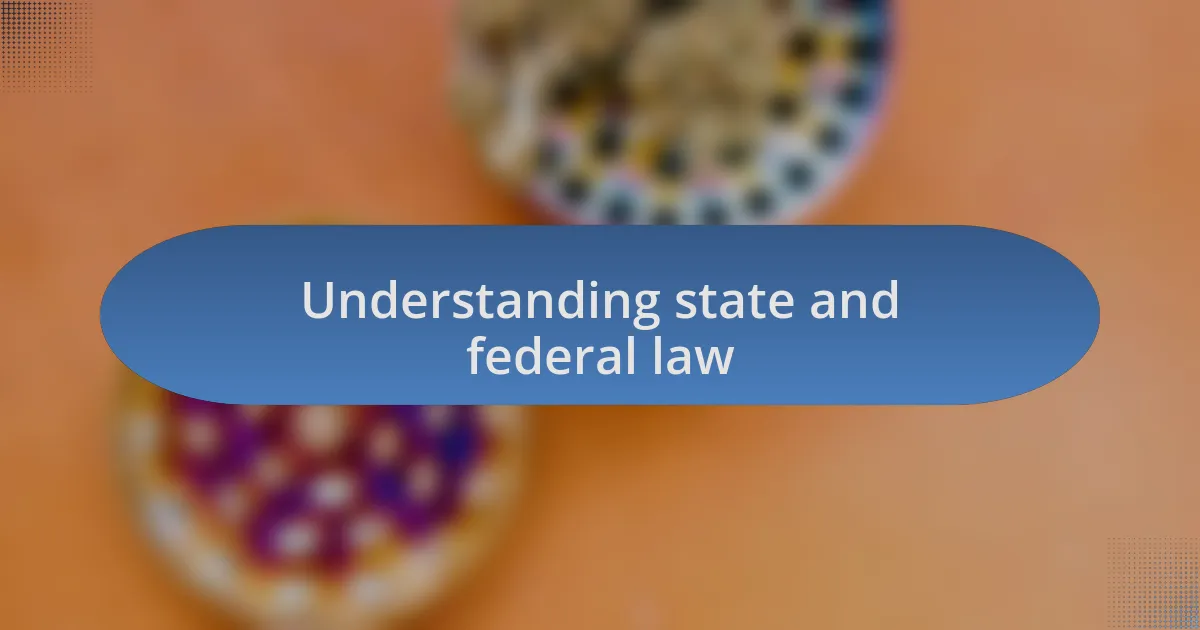Key takeaways:
- There is a significant disconnect between state and federal cannabis laws, creating confusion and anxiety for businesses and consumers.
- Understanding both laws and regulations is crucial, as local regulations can vary widely, affecting business viability and compliance.
- Legalization trends are reshaping public perception, but challenges remain due to federal restrictions impacting market access and growth for cannabis businesses.
- Community education and advocacy are essential to bridge the gap in understanding cannabis laws and to support those affected by legal discrepancies.

Understanding state and federal law
Navigating the complexities of state and federal law can feel like walking a tightrope, especially when it comes to cannabis. My experience has shown me just how bewildering it can be when a state legalizes cannabis while the federal government still classifies it as a Schedule I substance. Have you ever felt confused about what laws actually apply to you based on where you live?
I recall a moment when a friend from a fully legal state expressed frustration over federal banking restrictions that affected their cannabis business. It struck me how these inconsistencies create a grey area where compliance can be daunting for entrepreneurs. The emotions tied to operating in such an environment can lead to anxiety and uncertainty—who wouldn’t feel stressed trying to operate legally when the rules differ so drastically?
Understanding these layers of law requires attention to detail. I often advise people to research their local regulations thoroughly. Are you aware of how your state laws interact with federal guidelines? This knowledge can be empowering, as it helps in making informed decisions and mitigating risks associated with non-compliance.

Overview of cannabis law
Cannabis law is a multifaceted landscape, constantly evolving as states forge their paths while the federal government lags behind. I remember attending a cannabis conference where a panel discussed the recent shifts in legalization and how they directly impacted local communities. It was fascinating to hear firsthand accounts of how businesses flourished under state laws, yet faced crippling challenges due to federal restrictions. How can anyone plan for the future when the legal terrain is so riddled with uncertainty?
When I think about the patchwork of regulations across the country, I often wonder how everyday individuals navigate this maze. In my experience, confusion is rampant, especially when local laws offer protections that federal statutes do not recognize. For example, I once spoke with an individual who was apprehensive about visiting their dispensary, afraid of federal repercussions despite being in a legalized state. These stories highlight the urgent need for clearer communication around cannabis regulations.
Ultimately, understanding cannabis law goes beyond just knowing the rules; it’s about grasping how these laws impact lives and communities. I’ve seen small businesses thrive or falter based on their familiarity with local statutes and the nuances of federal law. The stakes are high, and fostering a comprehensive understanding is essential not just for compliance, but for supporting the vibrant cannabis culture that is emerging across the nation.

Impact of legalization trends
Legalization trends have sparked a dramatic shift in public perception and acceptance of cannabis. I remember when I first attended a cannabis expo years ago; the energy was palpable, filled with enthusiasm from entrepreneurs and advocates who believed in the plant’s potential. I often think about how far we’ve come since then, as more states embrace legalization and recognize the economic benefits. Isn’t it remarkable how a change in laws can transform the narrative around something once deemed taboo?
As states continue to take the lead, I’ve noticed that these trends create ripples beyond their borders. They challenge traditional views and pave the way for future legislation, both at the state and federal levels. In one discussion with a fellow cannabis enthusiast, we mused about the implications of legalization for social justice. It’s heartbreaking to reflect on the countless lives disrupted by prohibition, and seeing states address these injustices through their laws feels like a step toward healing.
Moreover, the divergent paths of state and federal laws lead to a fragmented market that can feel intimidating. I recall a conversation I had with a small business owner who found themselves struggling between adhering to state regulations while facing repercussions from federal law. They expressed feelings of anxiety and frustration; this tension underscores how crucial it is for lawmakers to harmonize regulations. When will we see a unified approach that supports not just businesses, but the communities they serve?

Differences between laws and regulations
The distinction between laws and regulations can be quite nuanced. In my experience, laws are broader legal principles enacted by legislatures, whereas regulations are specific rules created by governmental agencies to implement those laws. For instance, when a state legalizes cannabis, the specific guidelines dictating how it can be cultivated or sold are the regulations stemming from that law.
I remember discussing this difference with a friend who was puzzled about why some cannabis businesses operated differently from others. I explained that while the state law permits cannabis use, the regulations vary widely from one locality to another. This means that a dispensary in one city may be flourishing while another just a few miles away is struggling to comply with stricter regulations. It’s a classic case of how the details matter immensely, often influencing business viability.
It’s fascinating to think about how these dynamics play out in practice. The regulations often reflect the political climate and social attitudes in a state, which can shift rapidly. I once had a lively conversation with a local activist who emphasized the need for community input in shaping these regulations. I found myself agreeing wholeheartedly—without that feedback, how can we ensure that the rules serve the people they impact?

Implications for cannabis businesses
Navigating the complex landscape of state versus federal law has significant implications for cannabis businesses. I once met a business owner who shared the story of how federal prohibition led him to operate in constant uncertainty. He had to invest heavily in compliance to state regulations while fearing federal raids at any moment. This precarious situation underscores how the disconnect between state legality and federal illegality can create barriers that stifle growth and innovation in the cannabis industry.
Another aspect worth considering is market access; many banks and financial institutions shy away from serving cannabis businesses due to federal restrictions. During a recent industry event, I spoke with an entrepreneur who faced enormous challenges securing funding for expansion. The shifting legal environment often leaves these businesses without essential financial services, making it harder to compete and thrive. Can a business truly flourish when it operates outside the mainstream financial system? Experience tells me that it’s a daunting uphill battle.
Moreover, the evolving laws can lead to confusion among consumers, affecting sales and public perception. I remember chatting with a customer who was unsure about the legality of purchasing cannabis even in a state where it was legal. This uncertainty can deter potential customers, impacting the bottom line. How can businesses effectively educate their clientele when the legal landscape is so fragmented? It’s clear that these implications extend far beyond the realm of legality; they dive deep into consumer trust and long-term sustainability.

My experiences at cannabis expo
My experiences at the cannabis expo were eye-opening and filled with real-life stories that highlighted the stark contrasts between state and federal laws. I remember attending a workshop where various business leaders discussed their triumphs and tribulations. One entrepreneur shared how they navigated the challenging waters of federal regulations while trying to cultivate a thriving business. It really put into perspective how resilient individuals in this industry need to be.
In another conversation, I spoke with a grower who expressed their frustration over licensure hurdles in their state. They had dreams of expanding their operations, but federal restrictions loomed like an invisible wall. Listening to their struggles resonated with me; it made me ponder, how many innovative ideas and potential startups are we losing because of this legal limbo? It’s a heartbreaking thought.
The expo also allowed me to engage with consumers directly, and one interaction stood out vividly. A curious attendee approached me, puzzled by the legal nuances between states. They wanted to know if they were in danger just by purchasing cannabis legally where they lived. I could see the concern in their eyes, reminding me that education is vital. How can we bridge this gap between laws and consumer understanding? It’s a question that lingers, compelling us to think about our roles in creating a more informed community.

Lessons learned from cannabis expo
Attending the cannabis expo taught me just how critical it is to stay informed about changing laws and regulations. I recall a passionate discussion with a licensing expert who shared tips on how state laws can differ dramatically in interpretation and enforcement. It was a revelation for me – how can we expect businesses to thrive when the rules are so inconsistent? It sparked in me a deeper appreciation for the adaptability required in this evolving market.
One poignant moment at the expo involved a panel discussion where a lawyer shared stories of clients facing dire consequences due to federal enforcement actions. The stories were filled with emotion, revealing the human side of legislation. Listening to these experiences made me wonder: how many lives are impacted by these legal discrepancies? It was clear that for every law, there are real people behind the statistics, emphasizing the need for advocacy and reform.
Reflecting on my time there, I realized that the cannabis community is built on shared knowledge and support. During a break, while chatting with a group of advocates, I felt an electric sense of camaraderie. We exchanged ideas on how to educate the public about their rights and the complexities of cannabis law. It made me reflect: what responsibility do we all have in raising awareness? It’s not just about compliance; it’s about empowering each other to navigate these challenging waters together.